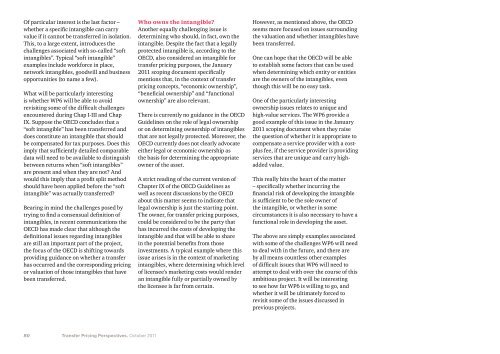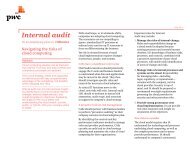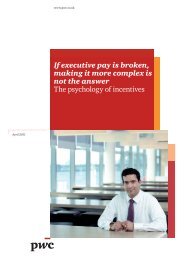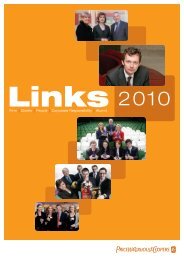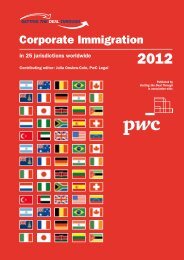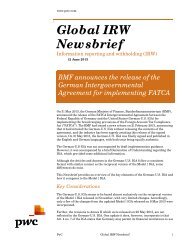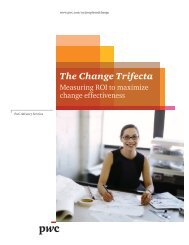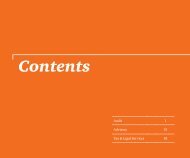Transfer pricing perspectives: Winds of Change - PwC
Transfer pricing perspectives: Winds of Change - PwC
Transfer pricing perspectives: Winds of Change - PwC
You also want an ePaper? Increase the reach of your titles
YUMPU automatically turns print PDFs into web optimized ePapers that Google loves.
Of particular interest is the last factor –whether a specific intangible can carryvalue if it cannot be transferred in isolation.This, to a large extent, introduces thechallenges associated with so-called “s<strong>of</strong>tintangibles”. Typical “s<strong>of</strong>t intangible”examples include workforce in place,network intangibles, goodwill and businessopportunities (to name a few).What will be particularly interestingis whether WP6 will be able to avoidrevisiting some <strong>of</strong> the difficult challengesencountered during Chap I‐III and ChapIX. Suppose the OECD concludes that a“s<strong>of</strong>t intangible” has been transferred anddoes constitute an intangible that shouldbe compensated for tax purposes. Does thisimply that sufficiently detailed comparabledata will need to be available to distinguishbetween returns when “s<strong>of</strong>t intangibles”are present and when they are not? Andwould this imply that a pr<strong>of</strong>it split methodshould have been applied before the “s<strong>of</strong>tintangible” was actually transferred?Bearing in mind the challenges posed bytrying to find a consensual definition <strong>of</strong>intangibles, in recent communications theOECD has made clear that although thedefinitional issues regarding intangiblesare still an important part <strong>of</strong> the project,the focus <strong>of</strong> the OECD is shifting towardsproviding guidance on whether a transferhas occurred and the corresponding <strong>pricing</strong>or valuation <strong>of</strong> those intangibles that havebeen transferred.Who owns the intangible?Another equally challenging issue isdetermining who should, in fact, own theintangible. Despite the fact that a legallyprotected intangible is, according to theOECD, also considered an intangible fortransfer <strong>pricing</strong> purposes, the January2011 scoping document specificallymentions that, in the context <strong>of</strong> transfer<strong>pricing</strong> concepts, “economic ownership”,“beneficial ownership” and “functionalownership” are also relevant.There is currently no guidance in the OECDGuidelines on the role <strong>of</strong> legal ownershipor on determining ownership <strong>of</strong> intangiblesthat are not legally protected. Moreover, theOECD currently does not clearly advocateeither legal or economic ownership asthe basis for determining the appropriateowner <strong>of</strong> the asset.A strict reading <strong>of</strong> the current version <strong>of</strong>Chapter IX <strong>of</strong> the OECD Guidelines aswell as recent discussions by the OECDabout this matter seems to indicate thatlegal ownership is just the starting point.The owner, for transfer <strong>pricing</strong> purposes,could be considered to be the party thathas incurred the costs <strong>of</strong> developing theintangible and that will be able to sharein the potential benefits from thoseinvestments. A typical example where thisissue arises is in the context <strong>of</strong> marketingintangibles, where determining which level<strong>of</strong> licensee’s marketing costs would renderan intangible fully or partially owned bythe licensee is far from certain.However, as mentioned above, the OECDseems more focused on issues surroundingthe valuation and whether intangibles havebeen transferred.One can hope that the OECD will be ableto establish some factors that can be usedwhen determining which entity or entitiesare the owners <strong>of</strong> the intangibles, eventhough this will be no easy task.One <strong>of</strong> the particularly interestingownership issues relates to unique andhigh-value services. The WP6 provide agood example <strong>of</strong> this issue in the January2011 scoping document when they raisethe question <strong>of</strong> whether it is appropriate tocompensate a service provider with a costplusfee, if the service provider is providingservices that are unique and carry highaddedvalue.This really hits the heart <strong>of</strong> the matter– specifically whether incurring thefinancial risk <strong>of</strong> developing the intangibleis sufficient to be the sole owner <strong>of</strong>the intangible, or whether in somecircumstances it is also necessary to have afunctional role in developing the asset.The above are simply examples associatedwith some <strong>of</strong> the challenges WP6 will needto deal with in the future, and there areby all means countless other examples<strong>of</strong> difficult issues that WP6 will need toattempt to deal with over the course <strong>of</strong> thisambitious project. It will be interestingto see how far WP6 is willing to go, andwhether it will be ultimately forced torevisit some <strong>of</strong> the issues discussed inprevious projects.80 <strong>Transfer</strong> Pricing Perspectives. October 2011


